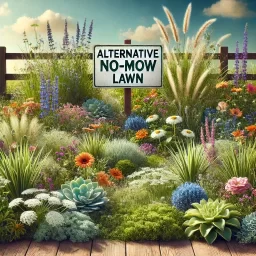
Table of Contents
No Mow Lawns: A Sustainable and Low-Maintenance Alternative
What are No Mow Lawns?
Maintaining a traditional lawn can be both time-consuming and resource-intensive. With the rise of sustainable living, No Mow Lawns are becoming an increasingly popular alternative. These lawns offer a low-maintenance, environmentally-friendly option that requires minimal upkeep compared to conventional lawns. In this article, we’ll explore the pros and cons of No Mow Lawns, the costs involved, and the best plant options for creating a beautiful, resilient landscape.
Pros of No Mow Lawns
1. Low Maintenance
One of the primary benefits of No Mow Lawns is their minimal upkeep. Unlike traditional lawns that demand frequent mowing, fertilizing, and watering, No Mow Lawns typically consist of ground cover plants that require little to no maintenance. This significantly reduces the time and costs associated with lawn care.
2. Environmental Benefits
By reducing the need for mowing, No Mow Lawns also help lower carbon emissions. Lawn mowers, particularly gas-powered models, contribute to pollution. Additionally, these lawns often consist of drought-tolerant plants that support local biodiversity by providing habitats for pollinators such as bees and butterflies. In doing so, they promote a healthier ecosystem.
3. Water Conservation
Most No Mow Lawns feature drought-resistant plants that require far less water than traditional grass lawns. This makes them an ideal choice for regions that experience frequent droughts or areas where water conservation is a priority. Homeowners can save money on water bills while also helping to protect the environment.
4. Aesthetic Variety
Another advantage of No Mow Lawns is the diversity they offer. Traditional grass lawns often lack variety, but No Mow Lawns can be created with a wide range of plant species, each offering different textures, colors, and visual appeal. This results in a more interesting and dynamic landscape.
Cons of No Mow Lawns
1. Higher Initial Costs
While the long-term maintenance costs of No Mow Lawns are low, the initial setup can be more expensive. Preparing the soil, purchasing drought-tolerant plants, and installing the lawn may require a larger upfront investment. However, many find the long-term savings to be well worth the initial cost.
2. Longer Establishment Period
Compared to traditional lawns, No Mow Lawns take longer to establish. Grass can be laid with sod and show immediate results, whereas the plants in No Mow Lawns need time to grow and fill in. This process requires patience, but once fully established, they become highly resilient and low-maintenance.
3. Weed Control
During the establishment phase, No Mow Lawns may require more frequent weeding to prevent invasive species from taking over. However, with the proper ground cover plants, weed growth will eventually be suppressed, reducing the need for further interventions.
4. Limited Durability
One drawback of No Mow Lawns is their ability to withstand heavy foot traffic. Unlike traditional grass lawns, many plants used in these lawns are not as durable under regular use, which can limit their practicality for play areas or spaces with frequent outdoor activities.
Costs of No Mow Lawns
The costs of establishing a No Mow Lawn can vary based on factors such as plant species, size of the area, and the extent of soil preparation. On average, homeowners can expect to pay between $0.50 and $5.00 per square foot to install a No Mow Lawn.
- Initial Costs: The largest expenses come from purchasing plants and preparing the soil. If you’re converting an existing lawn into a no-mow alternative, additional expenses for removing grass and tilling may be required.
- Maintenance Costs: After the lawn is established, the ongoing maintenance is minimal. Occasional weeding and watering during dry periods are typically the only necessary upkeep, significantly lowering long-term costs.
Plant Options for No Mow Lawns
There are several plant species ideal for creating a No Mow Lawn, each offering unique benefits. Below are some popular options:
1. Clover (Trifolium repens)
Clover is one of the most popular choices for No Mow Lawns due to its drought tolerance and nitrogen-fixing abilities, which naturally enrich the soil. It provides a soft, lush green cover that requires minimal care.
2. Creeping Thyme (Thymus serpyllum)
Known for its fragrant blooms, creeping thyme is an excellent choice for areas with light foot traffic. It’s drought-tolerant, low-growing, and requires little to no mowing, making it ideal for a No Mow Lawn.
3. Buffalo Grass (Buchloe dactyloides)
Buffalo grass is a native grass that requires minimal water and grows slowly, meaning it seldom needs to be mowed. It can withstand a variety of climates and is ideal for those seeking a traditional grass appearance in a No Mow Lawn.
4. Dichondra (Dichondra repens)
This low-maintenance ground cover is heat and drought-tolerant, forming a dense, lush carpet. Dichondra is perfect for warmer climates and provides a visually appealing alternative to traditional grass.
5. Sedum (Sedum spp.)
Sedums are succulent plants that come in various textures and colors, making them ideal for adding variety to your No Mow Lawn. They thrive in dry conditions and require minimal care.
Conclusion
Switching to No Mow Lawns offers a sustainable, eco-friendly, and low-maintenance alternative to traditional grass lawns. While there are some initial costs and challenges in establishing these lawns, the long-term benefits—such as reduced water usage, lower maintenance needs, and environmental advantages—make them a worthwhile investment. By choosing the right plants and taking the time to establish your No Mow Lawn, you can enjoy a beautiful, functional, and sustainable landscape that supports biodiversity and conserves resources.
